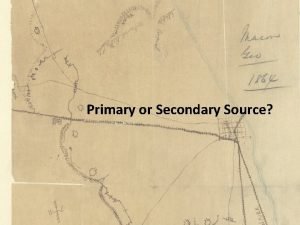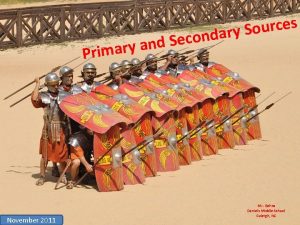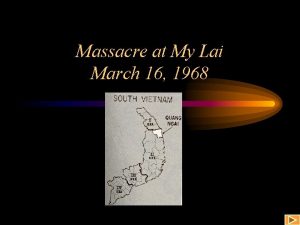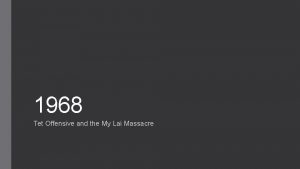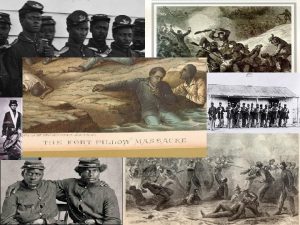Historical Sources as Evidence Primary Secondary Examples of



























































- Slides: 59

Historical Sources as Evidence Primary Secondary Examples of each

�Tells you about an event and is from the time of that event. �The source will have not had any analysis. It is the job of the historian to piece the sources of evidence together to explain the events that occurred. Primary Sources

�Speeches, documents, letters Primary Documents

�Political Cartoons Primary

�Photos or videos Primary

�Tells you about an event but is from a time after that event. �Usually talks ABOUT a primary source �They tell the story of history as an interpretation of past info. May have a bias or make a judgment. �WHY? �Examples: analysis by a text book, teacher or another individual talking about an event. Secondary

Short Video – Primary vs. Secondary

Provinces, Territories, Districts and British Possessions British Columbia Alberta Saskatchewan Manitoba Ontario Quebec New Brunswick Nova Scotia Prince Edward Island Northwest Territories Yukon Territory British Possessions Canada in 1905 District Boundaries - -- Offshore

�At the beginning of the 20 th century most countries had their own governments, but they still were not able to settle their own disputes with other countries. �For Canada (BC in Particular) this became a problem when negotiating over the Alaska “Panhandle” during the Alaska Boundary Dispute.

Green – BC Red – Canada Blue – US Yellow - Current Alaska Boundary Dispute

�What Act helped give Canada independence later on in the 20 th century?

�What Act helped give Canada independence later on in the 20 th century? �The Charter Act of 1867

“The sun never sets on the British Empire”

�- Many Canadians were angry with the deal but still felt proud to be British Subjects and wanted the British Empire to expand. This action is called imperialism. Many C fough anadian s t for Brita durin in g the Boe War r in Af rica

�Some Canadians believed that Britain was acting in the best interests of Canada, some did not ◦ Imperialist – a supporter of extending the rule of one country over another ◦ Nationalist – a supporter of national independence ◦ French-speaking Canadians did not support Britain – called themselves Canadiens �The French language was generally not accepted Attitudes

�Did all Canadians feel this loyalty to Britian?

�French speaking Canadians did not feel the same connection to the British because they were decedents of people who had settled New France. I am Canadien!

�The French believed that Canada should have autonomy and become completely independent from Britian. Therefore they were considered nationalists. 1. Define Nationalist 2. What part of the French culture was most important?

�Two events made the gap between the English and French grow even larger: ◦ 1. Henery Bourassa, nationalist leader, resigned from Laurier’s cabinet to show his disapproval with Canada’s involvement in the Boer war (South Africa). ◦ 2. French Canadians lost the right to speak French in catholic schools in Manitoba, Saskatchewan and Alberta.

�Read Still a British Nation (pg. 7 -8) brainstorm with a partner and create a Venn diagram. 1. On one side write points that refer to the English Canadian view on Britain 2. On the other side write points that refer to the French Canadien view on Britain. 3. In the middle write any commonalities between the two groups. Venn Diagram

�To prosper, Canada needed more people �Advertised in the USA – “Last Best West” �Immigrants willing to farm were offered 160 acres for $10 (27 times the size of Hugh Boyd’s turf field) Population

�Many Canadians were ethnocentric – belief in the superiority of one’s own race/culture �Many new immigrants faced racism and discrimination �In 1907, Canada’s future Prime Minister: “British Columbia must remain a white man’s country” �Chinese Head Tax – a tax on new immigrants from China � 1907 – Asian riots in Vancouver � 1914 – Komagata Maru forced to return to India New Immigrants

�Pretend you are a French Canadien writing a letter to Prime Minister Wilfred Laurier. In your letter talk about why you are unhappy with the government and how they think it should change. ◦ Include: � 4 points about why you are unhappy with Canada’s current government � 3 ways to improve Canada’s government �Be Creative! Tuesday Dec. 1 Homework

Warm-up: Political Cartoons

- What issue or event does this cartoon deal with? - What message is this cartoon trying to get across? - What groups might find this cartoon amusing, and who would not. - Are there any stereotypes in this cartoon

- What issue or event does this cartoon deal with? - What message is this cartoon trying to get across? - Who is the intended audience?

�“Let me tell you, my fellow countrymen, that the twentieth century shall be the century of Canada and of Canadian development. For the next seventy-five years, nay for the next 100 years, Canada shall be the star towards which all men who love progress and freedom shall come” ◦ Wilfrid Laurier, 1904 Do you think Laurier was accurate in his quote? Why or why not?

Society in the Early 1920’s A Different Canada

�Most people lived on farms �Families were expected to attend church �People supported Britain �Laziness was thought to be the cause of poverty �Little tolerance for those who did not obey the law ◦ The death penalty existed (crimes against property) Society and Manners – Early 20 th ◦ Drunkenness was a crime Century

�By the early 20 th century the majority of Canadians were influence by Victoria England. This period was known for its appearance and moral strictness. Society and Manners

�What were some differences between the rich and the poor during this period? �Canadian families were expected to support Britain, work hard, and not disobey the law. �There was harsh punishment for those who broke the law including the death penalty. �Why was the death penalty not always an appropriate punishment for these criminals? Society and Manners

�- How did women’s wrote in 1914 differ from the rights of women today? �- Women didn’t have the right over property, children, or money after marriage, nor did they have the right to vote. �- A group of women called the suffragists campaigned for the right to vote. Women in the Early 20 th Century

What types of things do you think they tried to change? Poverty - child labour - Prohibition - pollution - ◦ They felt that with the vote, they could influence the gov’t. ◦ Nellie Mc. Clung campaigned for women’s rights Women in the early 20 th century

�Some of their common daily activities included: ◦ ◦ 1. Attending Church 2. Reading Books (Anne of Green Gables) 3. The Opera House 4. Outdoor Entertainment Art and Leisure

What do you think this poster means?

�Laurier decided that Canada needed more people to prosper and turned to immigration to increase the number of people living in Canada’s Changing Population


�The government offered immigrants who were healthy and had sufficient funds a farm of 160 acres for only 10$. The restrictions of this were: ◦ They had to build a house on the land ◦ Farm the land within 3 years �These immigrants were called homesteaders �Some immigrants moved to urban centers during the winter.

�Unfortunately many Canadians were ethnocentric. As a result many immigrants were not treated well once arriving to Canada �How do you think the French felt about immigration in Canada?

�What type of discrimination did many immigrants have to put up with?

�Language and clothing was ridiculed �Customs were not accepted �Forced to work the jobs no other Canadians wanted (hauling coal, packing fish, Canadian Pacific Railway) ◦ The Chinese workers were often given jobs of the CRP that nobody else wanted such as tunneling explosives �Stores vandalized Many were not even accepted into Canada (Komagata Maru – a ship of Sikh immigrants that were denied access to Vancouver)

�The Canadian government limited the number of Chinese immigrant entering Canada in 1885. ◦ 50$ Head tax in 1885 ◦ Vandalism – a mob of 9000 people wrecked businesses of Chinese and Japanese immigrants

�The government raised the "head tax" from $50 to $100 in 1900 and again in 1903 to $500. �On July 1 st 1923 the government tried to halt Chinese immigration altogether through the Chinese Exclusion Act. �It was repealed in 1947 – More than 20 years!!!

◦ Interesting Facts: �At this time $500 was equivalent to 2 years of labor. �Between 1885 and 1923, an estimated $23 millions in head tax was collected (this is worth over $1 billion today). �In the 1980’s Pierre Trudeau refused to issue an apology �“We cannot re-write history; we can only try to be just in our time”

• Today, how does Canada benefit from it’s ethnic diversity? • In what ways is the immigrant experience different today?

�When the Indian Act was passed in 1876 their lives started to change �Government was trying to assimilate them into society �Assimilate: Abandon their culture and traditions and adopt a European way of life ◦ What was the purpose of reserves? �To free up land for European settlers Aboriginal Peoples

◦ By 1880 many were living on reserves �Encouraged to take up farming but there were many problems: ◦ The soil on the reserves was not good for growing crops ◦ They traded all their land for animals and tools, but the animals were to small for plowing and the tools were not appropriate for farming. ◦ Were often denied access to leave the reserve to sell any crops they did grow

Early 1900’s - Urbanization - Changes in communication - Resources and the environment

�Although farm living was still popular, many Canadians were choosing to move to Towns and Cities. �Canada’s western cities began to expand. Winnipeg’s growing population inspired the nickname “Chicago of the North”. Population went from 42 340 in 1901 to 136 035 in 1911. Urbanization

�What are some of the social issues that come with city life?

House of a wealthy family House of a poor family - - - - - Examine figure 1 -10 (pg. 13)

�How do you think quality of life differed between the rich and poor?

�Canada’s economy started to grow as well. ◦ Some of the goods that were exported included timber, wheat and minerals (mining). �Klondike Gold Rush 1896 – Mining increased and investors and hopeful citizens flocked to the Yukon �How did electricity change the way factories were run? Economy

◦ Bigger and better machines ◦ More jobs in manufacturing ◦ Increase in the demand for consumer goods (brand names) How did electricity change the way factories were run?

�Radio – 1901 �Wireless Communication– 1914 (Titanic) �X-rays (use of the hospitals shifted) �Telephone (1870) �Automobiles Technology Changes


�Big corporations (eg. Maple Leaf) had little competition and could set high prices for their products while still paying their workers low wages. �How did trade unions help working conditions for factory workers? ◦ Better pay ◦ Reduced hours of work ◦ Safer conditions ◦ Striking �By 1914 Canada was entering a recession and international demand for our recourses went down. Corporate Giants

� 1914 The Fraser Canyon rockslide disaster at Hell’s gate Canyon – disastrous effects on the spawning beds of the sockeye salmon. Fraser Canyon Rockslide

�The First Nations people were directly affect by this disaster because their livelihood depended on the fish. �National Parks became more popular with the government to try and protect the land. Fraser Canyon Rockslide
 Secondary sources
Secondary sources Primary evidence vs secondary evidence
Primary evidence vs secondary evidence Primary evidence vs secondary evidence
Primary evidence vs secondary evidence Primary evidence vs secondary evidence
Primary evidence vs secondary evidence Jobs vancouver
Jobs vancouver Primary and secondary tertiary sources
Primary and secondary tertiary sources Primary and secondary sources
Primary and secondary sources Primary source of light
Primary source of light Venn diagram of primary and secondary succession
Venn diagram of primary and secondary succession Primary sources of light
Primary sources of light How to evaluate historical sources
How to evaluate historical sources Print and web sources
Print and web sources Importance of water sources
Importance of water sources Purpose of project planning
Purpose of project planning Primary, secondary, tertiary business
Primary, secondary, tertiary business Primary pollutants
Primary pollutants Primary vs secondary deviance
Primary vs secondary deviance Syndicated resources
Syndicated resources Is an illustration a primary or secondary source
Is an illustration a primary or secondary source Secondary source of brand knowledge
Secondary source of brand knowledge Ornaments primary or secondary source
Ornaments primary or secondary source Data collection secondary data sources
Data collection secondary data sources What are secondary sources
What are secondary sources Secondary sources
Secondary sources Primary sources
Primary sources Secondary sources
Secondary sources Secondary sources
Secondary sources Secondary sources of history
Secondary sources of history Are autobiographies primary sources
Are autobiographies primary sources Secondary sources of brand knowledge
Secondary sources of brand knowledge Syndicated secondary data
Syndicated secondary data Source of data collection
Source of data collection Bluebook secondary sources
Bluebook secondary sources Secondary sources of brand knowledge
Secondary sources of brand knowledge Lindisfarne raid primary sources
Lindisfarne raid primary sources Scientific revolution primary sources
Scientific revolution primary sources Jstor uncw
Jstor uncw Buffalo soldiers primary sources
Buffalo soldiers primary sources Primary source of autobiography
Primary source of autobiography Mai lai massacre primary sources
Mai lai massacre primary sources Athens and sparta primary sources
Athens and sparta primary sources Alexander the great hephaestion
Alexander the great hephaestion Execution de saigon
Execution de saigon Ancient greek olympics primary sources
Ancient greek olympics primary sources Defining and debating america's founding ideals
Defining and debating america's founding ideals Boston massacre primary sources
Boston massacre primary sources Who is xerxes
Who is xerxes Slave trade primary sources
Slave trade primary sources Persian empire primary sources
Persian empire primary sources Faithfull massacre
Faithfull massacre Fort pillow massacre primary sources
Fort pillow massacre primary sources Why is fiber considered class evidence
Why is fiber considered class evidence Class vs individual evidence
Class vs individual evidence How can class evidence have probative value
How can class evidence have probative value Class evidence vs individual evidence
Class evidence vs individual evidence Red herring fallacy
Red herring fallacy Primary and secondary effects of a tectonic hazard
Primary and secondary effects of a tectonic hazard Impact of business decisions on stakeholders
Impact of business decisions on stakeholders Planting more trees
Planting more trees Primary volcanic hazards
Primary volcanic hazards


















